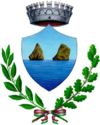Vietri sul Mare
| Vietri sul Mare | ||
|---|---|---|

|
|
|
| Country | Italy | |
| region | Campania | |
| province | Salerno (SA) | |
| Coordinates | 40 ° 40 ′ N , 14 ° 44 ′ E | |
| height | 80 m slm | |
| surface | 9 km² | |
| Residents | 7,562 (Dec 31, 2019) | |
| Population density | 840 inhabitants / km² | |
| Post Code | 84019 | |
| prefix | 089 | |
| ISTAT number | 065157 | |
| Popular name | Vietresi | |
| Patron saint | San Giovanni Battista (June 24th) | |
| Website | Vietri sul Mare | |
Vietri sul Mare is an Italian commune with 7562 inhabitants (as of December 31, 2019) in the province of Salerno in the Campania region . It belongs to the mountain commune Comunità Montana Penisola Amalfitana .
The fraction Albori is a member of the association I borghi più belli d'Italia (the most beautiful places in Italy).
The neighboring towns of Vietri sul Mare are Cava de 'Tirreni , Cetara , Maiori and Salerno .
Vietri ceramics
Vietri sul Mare is famous for the handcrafted colorful ceramics that are sold all over the coast. The well-known Vietri tiles, vases, plates and other ceramic objects were made here as early as the Middle Ages. Many houses and churches are decorated with traditional tiles, many with religious motifs. The cheerful colors reflect the turquoise sea, the blue sky and the green Mediterranean maquis .
In Raito, a district of Vietri sul Mare, the majolica of the Amalfi Coast is made. In the small village on a hill there is a ceramics museum, which is housed in a wing of the Villa Guariglia . In the ancient Toretta Belvedere tower, exhibits on the history of ceramic art from the 17th to 19th centuries are shown. From the 1920s there was a German artist colony in Raito that had a lasting influence on the ceramic style. Among them was Otto Pankok's student Richard Dölker (1896–1955), Irene Kowaliska-Wegner (1905–1991), Lisel Oppel (1897–1960) and Barbara Margarethe Thewalt-Hannasch (1901–1962). Inspired by the Mediterranean lifestyle on the Amalfi Coast, they created a colorful, naive world of images. One room in the museum is dedicated to the German phase (“periodo tedesco”).
The work of this German artist colony is closely linked to the ceramic factory founded by the German-Jewish entrepreneur Max Melamerson in 1926/1927, the "ICS" ("Industria Ceramica Salernitana" / Ceramic Industry Salernitana). Max Melamerson, born on October 17, 1881 in Suwalki (Poland), was based in Hamburg before his time in Vietri sul Mare. He founded the ICS in the workshops of the former ceramics company "Della Monica" in Marina di Vietri, probably in collaboration with Günther Stüdemann, the owner of the "Ceramica Fontana Limite". The ceramics produced in the ICS at that time replaced the traditional motifs (ornaments, flowers, fruits) that had prevailed up to now with those that took up inspiration from the immediate environment, especially figures and scenes from village life.
The story of the ICS under Max Melamerson is also part of the story of the exile of German artists on the Amalfi Coast. There were links to the exile community in Positano , including through Irene Kowaliska and Lisel Oppel. Ilse Bruck-Bondy, the mother of Michele Theile , moved with her son from Positano to Vietri sul Mare in 1940 for a year in the apartment of Max Melamerson and his wife Flora (Flora Haag, born on May 23, 1898 in Hamburg). Max Melamerson and his wife were interned on July 7 (Max) and September 14, 1940 (Flora), passed through several Italian internment camps and were liberated on September 10, 1943 from the “barracks town”, the Calabrian camp ghetto Ferramonti di Tarsia . You lived in Cosenza in 1945 .
Vietri sul Mare is part of the Amalfi Coast cultural landscape and is a UNESCO World Heritage Site .
Personalities
Birthplace of the Austrian author Humbert Fink (actually: Luigi Umberto Fink) (1933–1992) and the Italian chef Antonio Carluccio (1937–2017).
Demographics
Vietri sul Mare has 2781 private households . Between 1991 and 2001 the population fell from 9401 to 8543. This corresponds to a percentage decrease of 9.1%.

Panorama picture
Web links
- History of the ICS (in Italian)
- Günther Stüdemann
- The Guariglia villa
- L'Arte Della Ceramica a Vietri Sul Mare
Individual evidence
- ↑ Statistiche demografiche ISTAT. Monthly population statistics of the Istituto Nazionale di Statistica , as of December 31 of 2019.
- ^ I borghi più belli d'Italia. Borghipiubelliditalia.it, accessed September 9, 2017 (Italian).
- ↑ Some examples of the work of the aforementioned artists can be seen on the website L'ARTE DELLA CERAMICA A VIETRI SUL MARE .
- ^ Klaus Voigt: Refuge on revocation. Exile in Italy 1933-1945. Klett-Cotta, Stuttgart Volume 1: 1989, p. 463, ISBN 3-608-91487-0
- ^ ICS: history
- ^ Günther Stüdemann: Short biography
- ^ ICS: history
- ^ Klaus Voigt: Refuge on revocation. Exile in Italy 1933-1945. Klett-Cotta, Stuttgart Volume 1: 1989, p. 463, ISBN 3-608-91487-0
- ↑ Positano: The History of Artists
- ^ Klaus Voigt: Refuge on revocation. Exile in Italy 1933-1945 . Klett-Cotta, Stuttgart Volume 2: 1993, pp. 162ff, ISBN 3-608-91160-X
- ↑ Jewish foreigners interned in Italy



